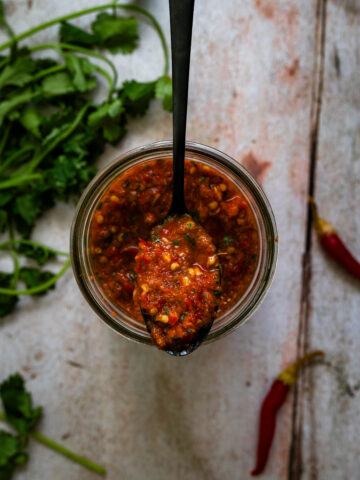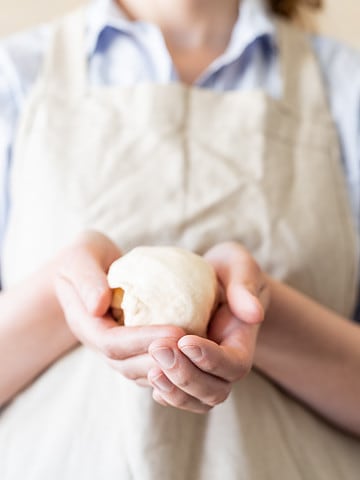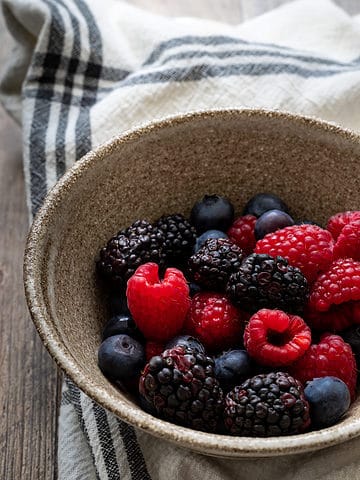This post contains affiliate links. This means I earn a small commission at no cost to you. You can view my affiliate disclosure here.
Easy fermented pesto using fermented basil leaves and garlic. Homemade pesto is a great way to preserve basil.

Last summer my garden produced a ton of Genovese basil! Apparently it grows very well in my area.
Most of my garden I have strategically planned out, but when it came to the basil, I just took the seed packet and sprinkled it in one area. I ended up with about 20-30 plants and filled my freezer with bags of basil since we couldn't eat it all fresh.
Recently, I was trying to clear out my freezer and came across the bags of basil. My favorite way to eat basil is when it's fresh but when it's frozen, you can still use it for pesto.
Pesto is very simple to make and only requires a few ingredients plus a blender. I like to ferment the basil leaves because of the probiotic benefits and make this into pesto. Honestly, I find the flavor very similar to unfermented pesto. so if you are worried about the fermented flavor-don't be!
Ingredients
4 cups filtered water
4 tsp salt (not table salt)
4 cups basil leaves stems removed
4 cloves garlic
2 tbsp walnuts or pine nuts
⅓ cup olive oil
¼ cup parmesan cheese (optional)

Instructions
First, bring the filtered water to a boil and add the salt. Stir and let the pot simmer until the salt dissolves.
Allow the water to cool down for a half hour.
Meanwhile, add the basil leaves and the garlic cloves to the mason jar. When the salt water brine has cooled, pour it overtop.
Add the fermentation weight on top of the basil leaves and garlic, making sure that the veggies are completely submerged below the brine.

Secure the fermentation lid or loosely place a jar lid on top and let the jar sit on the counter for 7-10 days.
After 7-10 days, strain the liquid from the jar and save it for adding to other ferments, cooking, or making broth.
Take the basil and garlic and add it to a blender. Also add the nuts, olive oil, and parmesan cheese if using. Blend until smooth.
Use the pesto for pasta, pizza, or your favorite recipe. I have stored fermented pesto in the fridge for up to a week, but I haven't tested the shelf life for longer than that.
If you make this recipe, be sure to leave me a star rating and a comment below. Share what you made and tag me on Instagram @keepingitholistic! For more scratch-made recipes and natural living tips, subscribe to my newsletter and follow me on YouTube and Instagram!
📖 Recipe

Equipment
- 1 small pot
- 1 mason jar (at least quart size)
- 1 fermentation lid (optional)
- 1 Blender
Ingredients
- 4 cups filtered water
- 4 teaspoon salt (not table salt)
- 4 cups basil leaves stems removed
- 4 cloves garlic
- 2 tablespoon walnuts or pine nuts
- ⅓ cup olive oil
- ¼ cup parmesan cheese (optional)
Instructions
- First, bring the filtered water to a boil and add the salt. Stir and let the pot simmer until the salt dissolves.
- Allow the water to cool down for a half hour.
- Meanwhile, add the basil leaves and the garlic cloves to the mason jar. When the salt water brine has cooled, pour it overtop.
- Add the fermentation weight on top of the basil leaves and garlic, making sure that the veggies are completely submerged below the brine.
- Secure the fermentation lid or loosely place a jar lid on top and let the jar sit on the counter for 7-10 days.
- After 7-10 days, strain the liquid from the jar and save it for adding to other ferments, cooking, or making broth.
- Take the basil and garlic and add it to a blender. Also add the nuts, olive oil, and parmesan cheese if using. Blend until smooth.
- Use the pesto for pasta, pizza, or your favorite recipe. I have stored fermented pesto in the fridge for up to a week, but I haven't tested the shelf life for longer than that.






Comments
No Comments